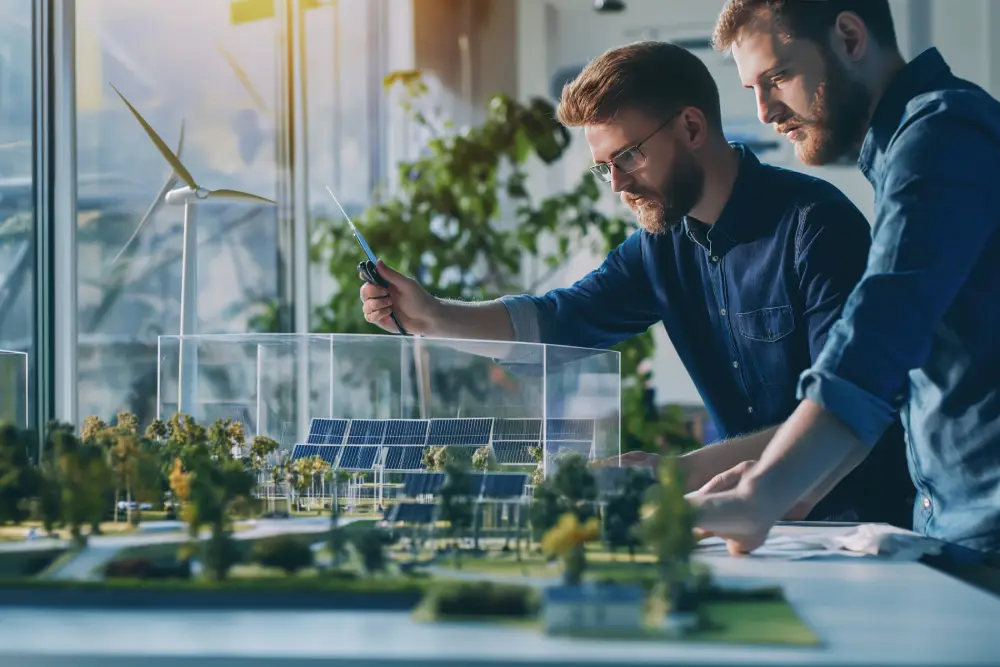Introduction
The demand for energy-efficient and eco-friendly buildings has led to a shift in the construction industry towards sustainable design and construction. As a crucial part of modern infrastructure, MEP (Mechanical, Electrical, and Plumbing) engineering plays a significant role in reducing energy consumption, optimizing resources, and ensuring environmental responsibility. This article explores how sustainable design and construction is shaping the future of MEP engineering and why it is essential for modern buildings.
1. What is Sustainable Design and Construction?
Sustainable design and construction refers to the practice of designing and building structures that minimize their environmental impact while maximizing efficiency and sustainability. This approach involves:
- Reducing energy and water consumption.
- Utilizing eco-friendly materials.
- Integrating renewable energy sources.
- Enhancing indoor air quality and occupant well-being.
- Designing for long-term durability and adaptability.
2. The Role of MEP Engineering in Sustainable Design
MEP engineers play a vital role in implementing sustainable design and construction by designing systems that optimize resource use and reduce waste. Their contributions include:
- Energy-Efficient HVAC Systems
Heating, ventilation, and air conditioning (HVAC) systems are among the largest consumers of energy in buildings. MEP engineers implement:
- High-efficiency HVAC systems that reduce energy consumption.
- Smart thermostats and automated climate control systems.
- Heat recovery ventilation (HRV) and energy recovery ventilation (ERV) systems.
- Geothermal and solar-assisted heating and cooling solutions.
- Renewable Energy Integration
Incorporating renewable energy sources is a core aspect of sustainable design and construction. MEP engineers facilitate:
- Solar photovoltaic (PV) panel installations for electricity generation.
- Wind turbines in large-scale projects where applicable.
- Battery storage systems for energy efficiency and backup.
- Integration of smart grids and microgrids to optimize power use.
- Water Conservation and Management
Water efficiency is crucial for sustainable buildings. Plumbing engineers focus on:
- Greywater recycling systems for non-potable uses such as irrigation and flushing.
- Rainwater harvesting systems to reduce dependency on municipal water supply.
- Low-flow fixtures and sensor-based faucets to minimize water wastage.
- Sustainable stormwater management solutions to prevent urban flooding.
- Smart Building Technologies
Advancements in IoT and automation have transformed MEP systems into highly efficient networks. Engineers incorporate:
- Building Management Systems (BMS) to monitor and control energy usage.
- Smart lighting solutions with daylight sensors and motion detectors.
- AI-driven energy optimization to reduce waste.
- Predictive maintenance technologies to improve system longevity.
- Sustainable Materials and Waste Reduction
Material selection is a key component of sustainable design and construction. MEP engineers contribute by:
- Using non-toxic, recyclable, and locally sourced materials.
- Designing prefabricated MEP systems to reduce on-site waste.
- Implementing modular construction techniques for efficiency.
- Utilizing biodegradable and energy-efficient insulation materials.
3. Benefits of Sustainable MEP Engineering
Emphasizing sustainable design and construction in MEP engineering provides multiple benefits, including:
- Lower Energy Costs: Efficient systems lead to significant savings in utility bills.
- Reduced Carbon Footprint: Integration of renewable energy minimizes environmental impact.
- Healthier Indoor Environments: Improved air quality and thermal comfort enhance occupant well-being.
- Regulatory Compliance: Meeting green building standards such as LEED, BREEAM, and WELL certifications.
- Increased Property Value: Sustainable buildings attract higher occupancy rates and investment potential.
4. Challenges in Implementing Sustainable MEP Engineering
Despite its advantages, implementing sustainable design and construction in MEP engineering comes with challenges:
- High Initial Costs: While sustainable systems provide long-term savings, the upfront investment can be high.
- Complex System Integration: Coordinating advanced MEP solutions within existing structures requires expertise.
- Regulatory Variability: Different regions have varying sustainability standards and requirements.
- Technological Adaptation: The fast pace of innovation requires continuous learning and adaptation by engineers.
- Limited Awareness: Some stakeholders still lack understanding of the long-term benefits of sustainable MEP engineering.
5. Future Trends in Sustainable MEP Engineering
The future of sustainable design and construction in MEP engineering is driven by technological advancements and regulatory changes. Emerging trends include:
- Net-Zero Energy Buildings (NZEBs): Structures designed to produce as much energy as they consume.
- AI and Machine Learning Integration: Optimizing energy consumption based on real-time data analysis.
- Advanced Prefabrication Techniques: Reducing material waste and construction timelines.
- Green Hydrogen and Alternative Fuels: Exploring renewable energy alternatives beyond solar and wind.
- Circular Economy Practices: Designing buildings with end-of-life material reuse in mind.
Conclusion
The adoption of sustainable design and construction is no longer an option but a necessity in modern MEP engineering. As buildings account for a significant portion of global energy use and emissions, integrating sustainable practices ensures long-term efficiency, cost savings, and environmental preservation. MEP engineers play a crucial role in this transition by designing innovative systems that optimize energy use, water management, and overall sustainability. By embracing emerging technologies and regulatory standards, sustainable design and construction will continue to shape the future of the built environment, leading to a greener and more efficient world.

